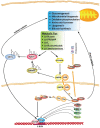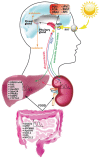Lipids around the Clock: Focus on Circadian Rhythms and Lipid Metabolism
- PMID: 25665169
- PMCID: PMC4381220
- DOI: 10.3390/biology4010104
Lipids around the Clock: Focus on Circadian Rhythms and Lipid Metabolism
Abstract
Disorders of lipid and lipoprotein metabolism and transport are responsible for the development of a large spectrum of pathologies, ranging from cardiovascular diseases, to metabolic syndrome, even to tumour development. Recently, a deeper knowledge of the molecular mechanisms that control our biological clock and circadian rhythms has been achieved. From these studies it has clearly emerged how the molecular clock tightly regulates every aspect of our lives, including our metabolism. This review analyses the organisation and functioning of the circadian clock and its relevance in the regulation of physiological processes. We also describe metabolism and transport of lipids and lipoproteins as an essential aspect for our health, and we will focus on how the circadian clock and lipid metabolism are greatly interconnected. Finally, we discuss how a deeper knowledge of this relationship might be useful to improve the recent spread of metabolic diseases.
Figures



Similar articles
-
Circadian Rhythms and Hormonal Homeostasis: Pathophysiological Implications.Biology (Basel). 2017 Feb 4;6(1):10. doi: 10.3390/biology6010010. Biology (Basel). 2017. PMID: 28165421 Free PMC article. Review.
-
Lipid metabolism around the body clocks.Prog Lipid Res. 2023 Jul;91:101235. doi: 10.1016/j.plipres.2023.101235. Epub 2023 May 13. Prog Lipid Res. 2023. PMID: 37187314 Review.
-
Circadian regulation of lipid metabolism.Proc Nutr Soc. 2016 Nov;75(4):440-450. doi: 10.1017/S0029665116000288. Epub 2016 May 26. Proc Nutr Soc. 2016. PMID: 27225642 Review.
-
Metabolic implications of circadian disruption.Pflugers Arch. 2020 May;472(5):513-526. doi: 10.1007/s00424-020-02381-6. Epub 2020 May 4. Pflugers Arch. 2020. PMID: 32363530 Review.
-
Circadian rhythm of lipid metabolism.Biochem Soc Trans. 2022 Jun 30;50(3):1191-1204. doi: 10.1042/BST20210508. Biochem Soc Trans. 2022. PMID: 35604112 Review.
Cited by
-
Metabolism as a New Avenue for Hepatocellular Carcinoma Therapy.Int J Mol Sci. 2023 Feb 13;24(4):3710. doi: 10.3390/ijms24043710. Int J Mol Sci. 2023. PMID: 36835122 Free PMC article. Review.
-
Analysing the Expression of Eight Clock Genes in Five Tissues From Fasting and Fed Sows.Front Genet. 2018 Oct 18;9:475. doi: 10.3389/fgene.2018.00475. eCollection 2018. Front Genet. 2018. PMID: 30405688 Free PMC article.
-
Chronic circadian desynchronization of feeding-fasting rhythm generates alterations in daily glycemia, LDL cholesterolemia and microbiota composition in mice.Front Nutr. 2023 Apr 14;10:1154647. doi: 10.3389/fnut.2023.1154647. eCollection 2023. Front Nutr. 2023. PMID: 37125029 Free PMC article.
-
Free-Living Humans Cross Cardiovascular Disease Risk Categories Due to Daily Rhythms in Cholesterol and Triglycerides.J Circadian Rhythms. 2019 Apr 24;17:3. doi: 10.5334/jcr.178. J Circadian Rhythms. 2019. PMID: 31065289 Free PMC article.
-
Daily rhythms in the morphometric parameters of hepatocytes and intestine of the European sea bass (Dicentrarchus labrax): influence of feeding time and hepatic zonation.J Comp Physiol B. 2021 May;191(3):503-515. doi: 10.1007/s00360-020-01334-w. Epub 2021 Feb 23. J Comp Physiol B. 2021. PMID: 33619590
References
-
- Foster R.G., Kreitzman L. Rhythms of Life: The Biological Clocks that Control the Daily Lives of Every Living Thing. Yale University Press; New Haven, CT, USA: 2004.
-
- De Mairan J.-J.O. Observation Botanique. [(accessed on 20 January 2015)]. Avaliable online: https://www.bibnum.education.fr/sciencesdelavie/biologie/observation-bot....
-
- De Candolle M. De l’influence de la lumiere sur les végétaux. Physiol. Vég. 1832;4:1069.
-
- Bünning E. The Physiological Clock–Circadian Rhythms in Biological Chronometry. The English University Press Ltd.; London, UK: 1973.
Publication types
LinkOut - more resources
Full Text Sources
Other Literature Sources

